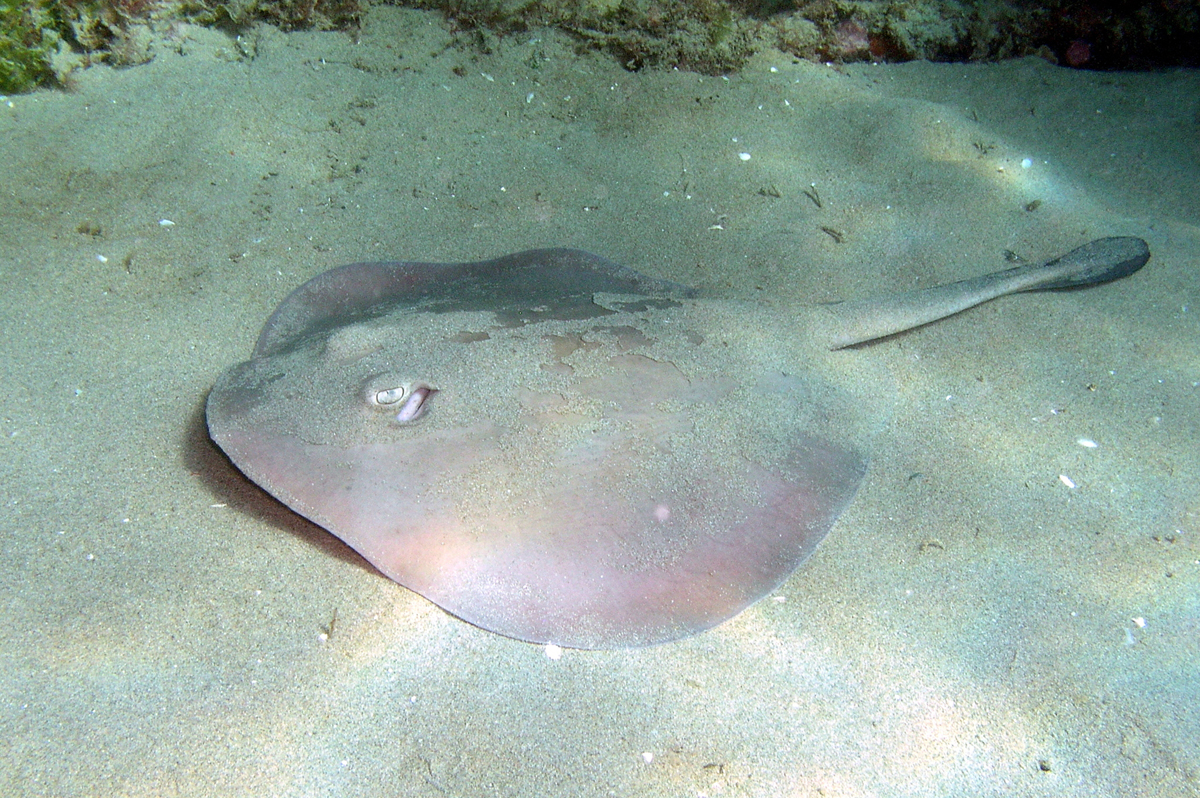Eastern Shovelnose Stingaree, Trygonoptera imitata Yearsley, Last & Gomon 2008

An Eastern Shovelnose Stingaree, Trygonoptera imitata, at Queenscliff, Port Phillip, Victoria, December 2016. Source: Sascha Schultz / iNaturalist.org. License: CC by Attribution-NonCommercial
A large plain brown to dark brown stingaree, sometimes with scattered darker and lighter spots, a pale underside usually with a broad darker margin. The species has a relatively deep-body, a smooth rhomboidal to subcircular disc, two venomous spines, a long fin on the tail and no dorsal fin.
A sting from the venomous spines may be excruciatingly painful.
Video of an Eastern Shovelnose Stingaree off Dendy Street Beach in Port Phillip, Victoria.
An Eastern Shovelnose Stingaree at Ulladulla, New South Wales.
Eastern Shovelnose Stingaree, Trygonoptera imitata Yearsley, Last & Gomon 2008
More Info
|
Distribution |
Newcastle, New South Wales, to Beachport, South Australia, including northern Tasmania. The species is common in Port Phillip Bay and Western Port, Victoria. Inhabits sandy and muddy areas in shallow bays, estuaries and inshore coastal waters at depths of about 5-120 metres (may occur in deeper waters in South Australia). |
|
Features |
Disc subcircular, wider than long, anterior edge obtuse; snout fleshy, tip not extended; eye diameter about 20–23% preocular snout length; posterior margin of spiracle angular; about 6 tiny papillae on mouth floor; internasal flap skirt-shaped, posterior angle not extended into distinct lobe; tail length 81–89% disc length; no dorsal fin; caudal fin lanceolate. |
|
Size |
To 80 cm TL. The largest known specimen measured 793 mm TL, with a disc width of 486 mm (a female). |
|
Colour |
Uniform greyish-brown or yellowish above, darkest on midline of head, central disc and tail, paler toward disc margin, with a few dark spots scattered irregularly on pectoral disc; centre of tail in juveniles with a blackish stripe from just before the pelvic fin base to the caudal fin. Underside pale over centre of disc, anterior margin, sides and posterior margins of disc similarly darker than central part of disc and tail; pelvic fins with a broad dark margin; some with irregular dark blotches on abdomen; tail uniformly dark.
|
|
Feeding |
Feeds mostly on bottom-dwelling invertebrates. |
|
Biology |
Females give birth to live young. Stingarees are aplacental viviparous, meaning that the embryos emerge from eggs within the uterus and undergo further development until they are born. After emerging from their egg cases, the embryos are initially sustained by their yolk, and later by histotroph, a "uterine milk" produced by the mother. |
|
Conservation |
|
|
Similar Species |
The Eastern Shovelnose Stingaree differs from Western Shovelnose Stingaree, Trygonoptera testacea (max length 47 cm TL), with which it is sympatric off the southeastern Australian coast, in lacking a dorsal fin, having a shorter prespiracular length, a deeper caudal fin, and a shorter prenasal length. It is much larger than the Common Stingaree, Trygonoptera mucosa (max length 44 cm TL), which also lacks a dorsal fin, and differs in having a shorter prespiracular length. |
|
Etymology |
The specific name imitata is from the Latin imitor (= copy, mimic), in reference to the similarity of this species with the Trygonoptera mucosa and T. testacea which it resembles in general appearance. |
|
Species Citation |
Trygonoptera imitata Yearsley, Last & Gomon, 200C, CSIRO Mar. Atmos. Res. Paper 022: 261. Type locality: East of Wilsons Promontory, Bass Strait, Victoria, Australia, 39°00'S, 146°35'E, depth 41-42 m. |
|
Author |
Bray, D.J. 2022 |
|
Resources |
Eastern Shovelnose Stingaree, Trygonoptera imitata Yearsley, Last & Gomon 2008
References
Gomon, M.F., Yearsley, G.K. & Last, P.R. 2008. Family Urolophidae. 125-137 pp. in Gomon. M.F., Bray, D.J. & Kuiter, R.H (eds). Fishes of Australia's Southern Coast. Sydney : Reed New Holland 928 pp. (126, as Trygonoptera sp.)
Kuiter, R.H. 1993. Coastal Fishes of South-eastern Australia. Bathurst : Crawford House Press 437 pp. (22, as Trygonoptera sp. 2)
Last, P.R. & Stevens, J.D. 1994. Sharks and Rays of Australia. Canberra : CSIRO Australia 513 pp. 84 pls (423, as Trygonoptera sp. B)
Last, P.R. & Stevens, J.D. 2009. Sharks and Rays of Australia. Collingwood : CSIRO Publishing Australia 2, 550 pp.
Last, P.R., Yearsley, G.K. & White, W.T. 2016. Family Urolophidae pp. 676-705 in Last, P.R., White, W.T., de Carvalho, M.R., Séret, B., Stehmann, M.F.W. & & Naylor, G.J.P. (eds) Rays of the World. Melbourne: CSIRO Publishing, 800 pp.
Yearsley, G.K., Last, P.R. & Gomon, M.F. 2008. Trygonoptera imitata sp. nov., a new stingaree (Myliobatoidei: Urolophidae) from southeastern Australia. 261-268 in Last, P.R., White, W.T. & Pogonoski, J.J. (eds). Descriptions of new Australian chondrichthyans. CSIRO Marine and Atmospheric Research Paper No. 022: 1-358 http://hdl.handle.net/102.100.100/118353?index=1





